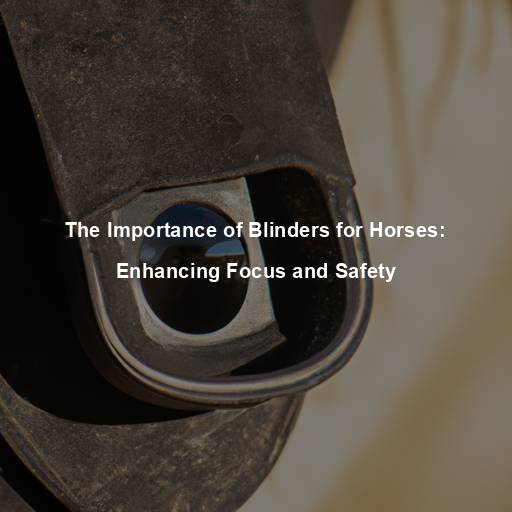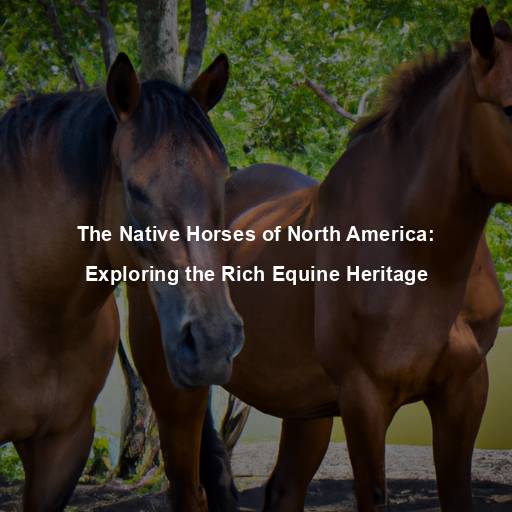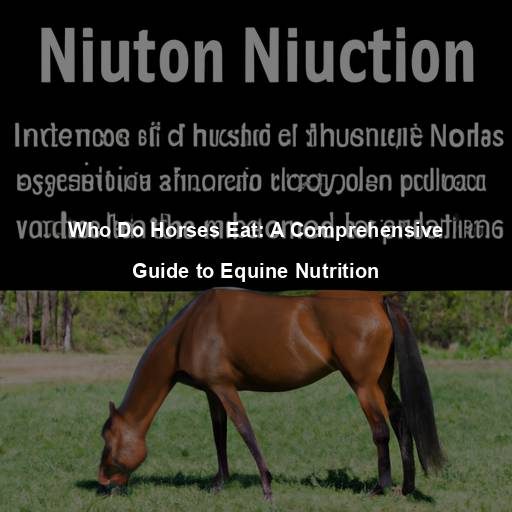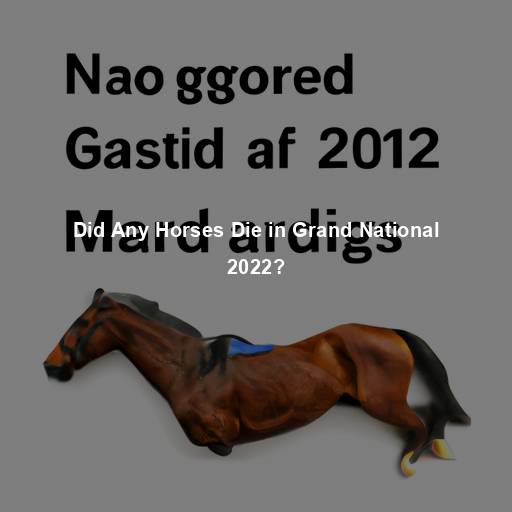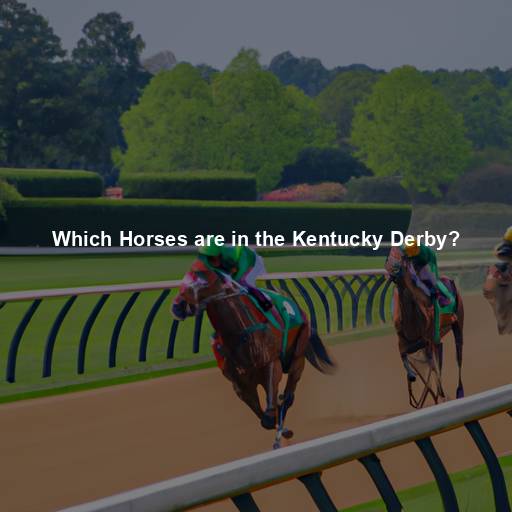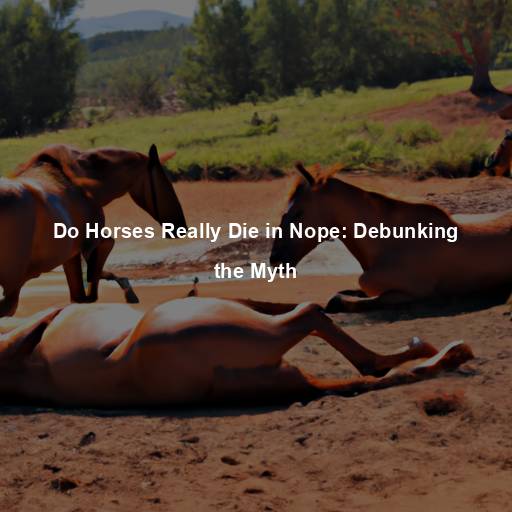The Importance of Blinders for Horses: Enhancing Focus and Safety
Last Updated on July 19, 2023 by Evan
Contents
Understanding the Purpose of Blinders
Imagine yourself on a tranquil equestrian adventure, where horses gracefully trot along, showcasing their undeniable elegance. Amidst this picturesque scene, you may notice a peculiar accessory attached to the bridles of these majestic creatures – blinders. Now, you may wonder: what purpose do these seemingly confining cups serve? Prepare to embark on a journey packed with intrigue and discovery as we unravel the enigmatic phenomenon of blinders, shedding light on their integral role in enhancing a horse’s concentration and safeguarding their well-being.
Minimizing Distractions
Horses possess an innate gift of perceiving the world around them with remarkable acuity. However, this exceptional sensitivity can sometimes lead them astray, as their attention wanders like a wayward gust of wind. Enter blinders, the ingenious contraptions that serve as equine eyewear, curbing those distractions that threaten to derail a horse’s focus. By creating a narrower field of vision and shielding the steed from potential disturbances, blinders pave the way for an amplified concentration, enhancing their performance and offering a sheltered voyage for riders and horses alike.
Encouraging Forward Movement
Blinders also play a vital role in encouraging forward movement in horses. By restricting the horse’s peripheral vision, blinders prevent them from fixating on objects or movements to the side. This encourages the horse to look straight ahead, maintaining a steady pace and direction. Whether on the racetrack, in the show ring, or during everyday riding, blinders help horses maintain a consistent stride and prevent them from veering off course.
Reducing Anxiety and Fear
Horses are prey animals, and their survival instincts can sometimes override their ability to focus on the task at hand. Blinders can help reduce anxiety and fear by creating a sense of security for the horse. By limiting their field of vision, blinders create a barrier between the horse and potential threats, such as other animals or unfamiliar objects. This can help the horse feel more confident and less likely to become spooked or startled.
Enhancing Performance in Competitive Settings
In the world of horse racing and show jumping, every fraction of a second counts. Blinders can give horses the competitive edge they need to excel in these high-pressure environments. By narrowing their focus and minimizing distractions, blinders allow horses to maintain their speed and concentration, helping them make split-second decisions and navigate challenging courses. This can greatly enhance their performance and increase their chances of success.
Promoting Safety
Ensuring the safety of all participants, both equine and human, is of the utmost importance in the world of horse-related activities. A key component in achieving this is the use of blinders, which serve as a protective measure against potential distractions and sudden actions that may lead to mishaps. By restricting the horse’s visual scope, blinders act as a shield, shielding them from unexpected stimuli that could trigger fear or unease. This additional level of safeguarding is particularly pivotal in high-pressure scenarios like fast-paced races, bustling urban settings, or demanding landscapes.
Addressing Potential Criticisms
Throughout generations, the practice of using blinders on horses has become deeply ingrained. However, there exists a growing chorus of dissenting voices expressing apprehension over its potential drawbacks. Detractors contend that this limited field of vision may impose undue stress or interfere with the horse’s innate instincts. Acknowledging these valid concerns is paramount, as it underscores the importance of responsible blinder usage that prioritizes the well-being of our equine companions.
When using blinders, it is crucial to consider factors such as the horse‘s temperament, training, and the specific activity they are engaged in. Proper fitting and regular breaks can also help alleviate any potential discomfort or stress. Consulting with experienced trainers, veterinarians, or equine experts can provide valuable insights and guidance on the appropriate use of blinders.
Full Cup Blinders
One common type of blinders is the full cup style. As the name suggests, these blinders completely cover the horse’s eyes, leaving no gaps for peripheral vision. Full cup blinders are often used in racing and other high-speed activities where precise focus and minimal distractions are crucial. The solid cup design provides maximum coverage and effectively blocks out distractions from all sides, allowing the horse to maintain a forward-facing gaze.
Half-Cup Blinders
If you’re searching for a way to strike the perfect equilibrium between focus and awareness for your horse, half-cup blinders might just be the answer. The intriguingly named half-blinders or half-cups offer a unique alternative to the fully-covered blinders we commonly see. Embracing the idea of balance, these blinders allow your equine companion to maintain some peripheral vision while minimizing distractions. It’s no wonder that show jumping and dressage enthusiasts favor this style, as it enables horses to stay attentive to both obstacles and the subtle cues from their riders.
Blinker Style Blinders
When it comes to horse racing gear, blinker-style blinders are taking the reins and shattering the mold of traditional cup blinders. Gone are the days of solid cups – blinkers boast a revolutionary design with small, hinged flaps that can be tailored to partially or fully cover a horse’s eyes. This flexibility provides trainers and riders with the power to customize a horse’s field of vision, catering to their specific needs and training goals. Whether it’s enhancing focus or minimizing distractions, blinkers offer a captivating blend of versatility and adaptability that is turning heads in the equestrian world.
Cheek Pieces with Blinders
In some cases, blinders are integrated into the cheek pieces of the horse’s bridle. These types of blinders are attached directly to the bridle and sit close to the horse’s eyes, providing a more integrated and streamlined design. Cheek piece blinders are often used in harness racing or carriage driving, where the horse’s field of vision needs to be restricted for safety and performance reasons. This style of blinders offers a secure and stable fit, minimizing the risk of the blinders shifting or becoming dislodged during intense activities.
Training and Introducing Blinders to Horses
When it comes to introducing blinders to our equine companions, a delicate dance of patience and understanding unfolds. We must navigate the realm of their comfort and acceptance, treading softly as we guide them into their new visual frontier. In this intricate process, the horse’s well-being takes center stage, demanding us to tread with utmost care, keenly attuned to any signs of stress or anxiety that may arise. As we embark on this journey, let us explore the key considerations that will pave the way for a harmonious union of horse and blinders.
Familiarization and Desensitization
Before attaching blinders to a horse, it is crucial to familiarize them with the equipment and desensitize them to the sensation of having their vision limited. Start by introducing the blinders to the horse in a calm and controlled environment. Allow them to sniff and investigate the blinders before gently placing them over the horse’s eyes for short periods. Gradually increase the duration over several sessions, ensuring the horse remains relaxed and comfortable.
Positive Reinforcement
When it comes to incorporating blinders into a horse’s training, one can’t underestimate the power of positive reinforcement. By rewarding the horse with treats, praise, or soothing gestures whenever they display calm behavior or make strides in accepting the blinders, you can foster a sense of encouragement. This approach helps the horse associate the presence of blinders with pleasant experiences, mitigating any resistance or initial unease that may arise.
Gradual Exposure to Distractions
As experienced trainers know, acclimating a horse to blinders involves a step-by-step approach filled with intrigue and puzzlement. Begin this captivating journey by introducing gentle whispers of distraction – slight movements and soft sounds to awaken the horse’s senses. As the horse embraces this enigmatic path, dare to escalate the enigma with more intricate and dynamic stimuli. Through this enigmatic process, the horse will find solace in focusing and staying poised amidst the bewildering distractions.
Regular Breaks and Monitoring
When using blinders, it is essential to provide the horse with regular breaks and monitor their behavior and comfort levels. Extended periods of wearing blinders without breaks can cause discomfort or stress for the horse. Ensure that the blinders are correctly fitted and do not cause any rubbing or irritation. Regularly check the horse’s eyes and facial expressions for any signs of discomfort or distress.
Understanding Equine Vision
To fully comprehend the benefits of blinders, it is essential to delve into the intricacies of equine vision. Horses possess monocular vision, meaning they can see different images with each eye independently. This unique visual system allows them to have a wide field of vision, encompassing almost 360 degrees. However, their binocular vision, which is the overlapping field of vision where depth perception is most accurate, is limited mainly to the area directly in front of them.
Utilizing Peripheral Vision
While horses have a remarkable ability to perceive motion and detect potential threats using their peripheral vision, it can also lead to distractions and anxiety in certain situations. The presence of blinders helps direct the horse’s focus forward, utilizing their binocular vision and enhancing their depth perception. By minimizing the distractions from the sides, blinders encourage horses to concentrate on the path ahead, whether it be on a racetrack or while navigating obstacles.
Heightened Sensitivity to Movement
Horses possess an inherent knack for detecting even the faintest of movements, rendering them prone to sudden leaps and jitters when faced with unexpected changes in their environment. However, there exists a curious solution to this predicament called blinders, a nifty contraption that restricts the horse’s field of vision. By curtailing peripheral visual input, these ingenious devices instill an air of reassurance, shielding the equine from fixating on disconcerting motions. The end result is an unruffled and composed disposition, empowering the noble creature to execute tasks with unwavering self-assurance and steadfastness.
Enhancing Depth Perception
When it comes to horses, their depth perception plays a vital role in various challenging tasks like jumping hurdles or tackling uneven terrains. To fine-tune this ability, blinders come into play, narrowing their field of vision. By doing so, horses become pros at estimating distances and evaluating the size of obstacles accurately. This newfound depth perception grants them the power to make seamless calculations, reducing the chances of accidents or misjudgments during jumps and maneuvers.
Psychological Comfort and Trust
Blinders, often cherished for their physiological perks, turn out to have a surprisingly profound effect on the psychological state of our equine friends. As prey animals, horses naturally harbor a sense of wariness, ever-ready to leap into a frantic frenzy at the slightest hint of danger. But here’s where the magic happens: by cleverly narrowing their visual perspective, blinders offer a soothing cloak of security, shielding horses from the overwhelming vulnerability that can plague their daily existence. It’s no wonder then that this ingenious invention not only mollifies anxiety but also fosters a bond of unspoken trust between horse and human.
Addressing Concerns and Criticisms
In the world of equestrianism, blinders have long claimed their spot as a go-to accessory. Yet, amidst their popularity, whispers of skepticism and disapproval echo in the stables. Detractors claim that these seemingly innocent eye coverings might disturb a horse’s innate instincts or trigger unwarranted anxiety. It becomes paramount, then, to navigate the fine line between considerate deployment of blinders and instances where overuse or abuse may blur the boundaries.
Individual Considerations
As equestrians, we understand that horses are as diverse as the colors that adorn their coats. Just like us humans, they have their own distinct personalities, training backgrounds, and individual needs that must be taken into account. When it comes to using blinders, it’s not a one-size-fits-all situation. The decision to incorporate them must be carefully examined and thoughtfully considered, as what might benefit one horse might not suit another.
Proper Fitting and Comfort
When it comes to blinders for horses, the fit and comfort are of utmost importance. It’s essential to make sure that the blinders are properly fitted to avoid any rubbing, irritation, or discomfort that could potentially have adverse effects on the horse’s well-being. Opting for blinders made from top-notch materials is a wise move to ensure the horse’s comfort and minimize the chances of any discomfort or distress. Remember, regular checks and adjustments are necessary to keep the horse content and happy with their blinders.
Training and Familiarization
Introducing blinders to a horse, dear readers, calls for an artful approach that embraces patience, understanding, and the application of positive reinforcement techniques. Hastening this process or coercing the horse to embrace the blinders without sensitivity can breed defiance and unease. To ensure a smooth transition and foster the horse’s comfort, consistent training and ample familiarization are paramount. Let us remember that time, compassion, and positive reinforcement can gently guide our equine companions towards accepting and adapting to this new equipment.
FAQs: Why do horses need blinders?
What are blinders?
Blinders, also known as blinkers, are a type of device that is attached to the bridle of a horse. They are made up of thin leather or plastic cups that are placed on either side of the horse’s head, near its eyes.
Why do horses need blinders?
Have you ever wondered why horses wear those peculiar blinders? Well, it turns out that these seemingly quirky accessories have a purpose beyond mere fashion. You see, blinders play a pivotal role in limiting a horse’s lateral vision. By blocking out distractions and narrowing their focus, blinders help keep these majestic creatures calm and composed, particularly in nerve-wracking situations like horse racing or intense activities that demand unwavering concentration. So, the next time you spot a horse trotting along sporting those curious blinders, know that there’s more to the story than meets the eye.
How do blinders benefit horses?
There’s something fascinating about the way blinders work their magic on horses. These ingenious accessories give our equine friends an extra dose of focus, shielding them from the temptations and terrors that lie beyond their immediate vision. With their sight limited to what lies straight ahead, blinders become accomplices in keeping horses firmly on the right track, undistracted and unfazed. It’s as if these simple pieces of gear whisper words of reassurance to our equine companions, cultivating a brave and calm demeanor that defies even their deepest fears.
Are blinders harmful to the horse?
When it comes to blinders for horses, there’s a conundrum to unravel. When utilized with care and precision, these accessories can be beneficial for our equine companions. But tread with caution, dear equestrians, for a misaligned or ill-fitting set of blinders can bring discomfort and obstruct a horse’s outlook. Remember, the decision to employ blinders should be made judiciously, consulting seasoned experts well-versed in the unique requirements of each noble steed.
Can blinders be used on all horses?
When it comes to the world of horses, there’s always a mysterious dance between their individual quirks and the tools we use to enhance their performance. Enter blinders, those curious accessories that have a knack for dividing opinions among equestrians. While they can work wonders for many horses, they might not be an absolute necessity for all. Whether a horse needs blinders or not is a puzzle that hinges on various factors: their temperament, training level, and the specific activity they’re engaging in. Some horses swagger with an air of confidence and a laser focus, while others are prone to being easily distracted or jumpy. To decode this enigma, it’s best to seek the wise counsel of an experienced equestrian who can help determine if blinders will be a fitting jigsaw piece for a particular horse.
Are blinders only used during horse racing?
While blinders are commonly associated with horse racing, they can be used in various other equestrian activities as well. Horses participating in carriage driving, show jumping, dressage, or even some trail riding may benefit from wearing blinders. The decision to use blinders in these activities will depend on factors such as the horse‘s individual needs, the level of concentration required, and the potential distractions present in the environment.
Can blinders cause a horse to become disoriented?
When it comes to the ever-controversial topic of blinders, the situation is as murky as an uncharted river. It’s been said that, under optimal circumstances, blinders can be a horse’s trusty companion, offering them a sense of focus and direction. Yet, the plot thickens as doubts emerge regarding the fitting and usage of these contraptions. Are they truly a horse’s guiding light, or could they potentially leave our equine friends in a state of utter confusion? The mystique surrounding blinders persists, highlighting the importance of meticulous fitting and ongoing monitoring to ensure the horse’s comfort and clarity of vision.

